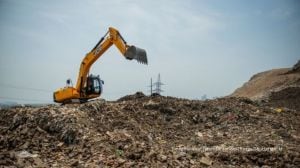Earthquakes: how prepared are we?
The recent seismic news from Bam was carried in our newspapers and TV channels with all the ingredients of competent earthquake coverage. Ex...

The recent seismic news from Bam was carried in our newspapers and TV channels with all the ingredients of competent earthquake coverage. Extensive photographs of the ruins, injured, and dead; the survivors, running after ambulances, rescue teams airdropped over the region, and so on. There was supplementary information provided — details of the four earthquakes that visited Iran over the last fifteen years, and so on.
But the larger point was missed. How prepared is India to face an occurrence of this kind? In fact, the Iranian and Indian seismic scenario are almost comparable. Over the last one and half decades or so, we have experienced three destructive earthquakes: Bihar in 1988; Latur in 1993; and Gujarat, 2001. These three earthquakes have taken a death toll of about 50,000 lives.
I had occasion to observe the destruction caused by some of these earthquakes at close quarters. Immediately after they occur, the epicentral area is visited by a large number of political heavyweights. A battalion of press correspondents and cameramen land on their “hunting missions” for the most moving visuals. Then experienced international economists (for financial aid), seismologists (for scientific opinion), and other “experts” proceed to ventilate their views. But within a few weeks, the attention shifts elsewhere and within a year an event that caused such monumental destruction is almost forgotten.
Yet the danger facing India from occurrences of this kind is an ubiquitous one. A perusal of research papers on Indian seismicity, published over the last two to four years, amply shows the latent seismic threat and terrestrial stress building activity has leaped from large scale to mega scale. Some reliable macro-seismic precursors have been observed, not only by researchers but also by ordinary people. A few rivulets and tributary rivers in upper Assam, for instance, have changed their course by ten or more kilometres. As a result a number of villages and agricultural fields have either vanished or shrunk in size. At some locations, the shifting of river is within few kilometers of the national highway. Some experts are even worried that the river shifting may adversely affect the national highway, which is the main artery for transport and communication for the entire Northeast. And there is basis for this apprehension.
According to Professor Arya, if an earthquake of a magnitude of 7.0 or more occurs during the night in the north India region (Himachal/ Uttarancal), the death toll could be as high or more than that of the Bam quake. Such an earthquake will be a big threat to the high rise buildings in Delhi. The possibility of Delhi becoming another Ahmedabad, where only tall buildings suffered heavy damage, cannot be ruled out. Similarly, there are reports by some of the authorised agencies and universities that some areas in Uttaranchal and Himachal has been exhibiting change of level indications, which could definitely be linked to a seismic precursory process. At a few locations, changes in level have been observed. Rising or sinking of land on a massive scale is definitely a reliable seismic precursor. Prior to the occurrence of the Bihar-Nepal earthquake of 1934, the land had risen about eight meters. Prior to the Gujarat earthquake, the level of the Kandla Port had risen by about 20 mm. The difference between the two height changes is due to the fact that one was a deep interior inland location, while the other was on the coast. Two other seismically vulnerable areas, as reported in research papers, are the Manipur-Myanmar border region and a site about 70 km north of Port Blair. At present the sites have been identified broadly and further refining of the location is possible with appropriate research.
After the Gujarat earthquake, there was some public focus on the issue of earthquake disaster mitigation. Several states have established cells for disaster mitigation and Uttaranchal is the first state in the country to have a ministry of disaster mitigation. But the efforts of these agencies tend to be painfully bureaucratic. Though these agencies have been doing some good work, their efforts do not seem to have reached the common man. Information on the work they are doing are yet to percolate down to the grassroots. Most of the popular publications are in English, which cannot be read by villagers. At present the most powerful mass media is television but there are no programmes to help create seismic awareness or on disaster mitigation on any government or private channel.
Clearly, we as a nation need to be better prepared to face the killer quake. The present suffering in the city of Bam should come as a timely warning that its fate could visit us and we need to be ready to face it.
Photos



- 01
- 02
- 03
- 04
- 05




























